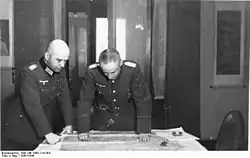Ernst August Köstring
Ernst-August Köstring (20 June 1876 – 20 November 1953) was a German diplomat and officer who served in World War II.
Ernst-August Köstring | |
|---|---|
 Köstring (right) along with Hans Krebs (1941) | |
| Born | 20 June 1876 Serebryanye Prudy, Moscow Governorate, Russian Empire |
| Died | 20 November 1953 (aged 77) Unterwössen, West Germany |
| Allegiance | |
| Service/ | Prussian Army Reichsheer Army (Wehrmacht) |
| Years of service | 1895–1933; 1935–45 |
| Rank | General of the Cavalry |
| Battles/wars | World War I World War II |
| Awards | Knight's Cross of the War Merit Cross with Swords |
Born in Imperial Russia in 1876, Ernst August Köstring grew up in St Petersburg (or Moscow[1])and was fluent in Russian.[2] He left Russia just before the World War I as many other Germans.[1] He took part in World War I, serving under Major General Hans von Seeckt in the Austro-Hungarian Seventh Army. After the war, he was retained in the Reichsheer. From 1919, he was back in the Prussian War Ministry and then detached to the Ministry of the Reichswehr in 1919 when that ministry was established.
On 1 August 1935, he was returned to active service as a military attaché to Russia and Lithuania and sent back to Moscow. During the invasion of Poland, as a German military attaché in Moscow Köstring played a key role in coordination between Nazi Germany and Soviet Union.[3] In September of 1939 he was involved in the Molotov–Ribbentrop Pact negotiations along with Colonel Heinrich Aschenbrenner.[4] On 8 August 1940, Köstring was warned by General Franz Halder that "he would have to answer a lot of questions soon",[2] making him one of a few people who knew what would happen with Russia despite the non-aggression pact. With the planned Operation Barbarossa his position in Moscow was untenable (right:); he was repatriated under diplomatic immunity and assigned to the Führerreserve. He visited, together with Friedrich Werner von Schulenburg, prisoner of war camps recruiting Soviet POWs for the German war effort. On 1 May 1941 German military delegation headed by Ernst August Köstring attended the Soviet military parade in Moscow in honor of International Workers' Day.
On 1 September 1942 when he was appointed "General Officer attached to Army Group A for Caucasian Questions" under General Eduard Wagner. In this role he worked on creating national legions among the indigenous people of the Caucasus, among them the Muslim Karachai. He arranged for Armenians, Georgians and other Caucasian populations to fight at the front after training in Poland. Most of the Armenians deserted.
The Karachai had formed an anti-Soviet committee under Qadi Bayramukov (ru) before the Germans arrived. Köstring invited them to the Bairam feast on 11 October. He was exceptionally well received and was carried shoulder high in celebration as was the custom.
In the spring of 1943 Köstring put into the Führer reserve. In mid-June 1943, he was appointed Inspector of the German commanded Turkic associations, on 1 January 1944 appointed the General of the "volunteer" organizations in the Army High Command. Throughout this period he spent most of his time helping with the creation of Andrey Vlasov's Russian Liberation Army. He surrendered on 4 May 1945 to the U.S. Army; he was released in 1947. He co-authored the 1946 book The Peoples of the Soviet Union[5] which was later used by the U.S. Army.[6]
References
- Vladimir Vinokurov. The role of German military diplomacy in adopting decision to attack USSR (Роль немецкой военной дипломатии в принятии решения о нападении на СССР). VPK-News. 6 August 2008
- Reitlinger, Gerald (1960). House Built on Sand: The Conflicts of German Policy in Russia 1941-45. Weidenfeld & Nicolson.
- Soviet-Polish War: The liberation campaign into Western Belarus and Western Ukraine (Советско-польская война: Освободительный поход в Западную Белоруссию и Западную Украину). hrono.ru
- Yulia Kantor. The sworn friendship: secret cooperation of USSR and Germany in 1920–1930s (Заклятая дружба: секретное сотрудничество СССР и Германии в 1920-1930-е годы).
- The Peoples of the Soviet Union (Corliss Lamont, 1946) online
- Corliss Lamont: United States Army had included my book, The Peoples of the Soviet Union, in a bibliography. The listing had appeared, without my knowing about it, in an Army manual entitled Psychological and Cultural Traits of Soviet Siberia, published in 1953 by the Intelligence Section of the U.S. General Staff.
Sources
- Mitcham, Samuel W. (2009) Men of Barbarossa: Commanders of the German Invasion of Russia 1941. Casemate.